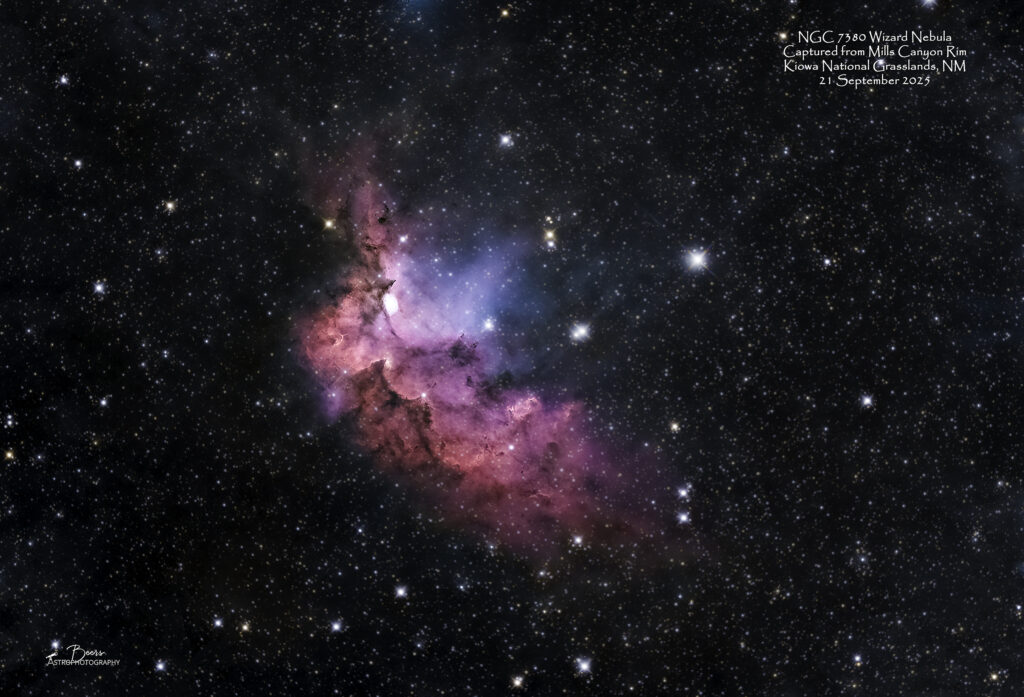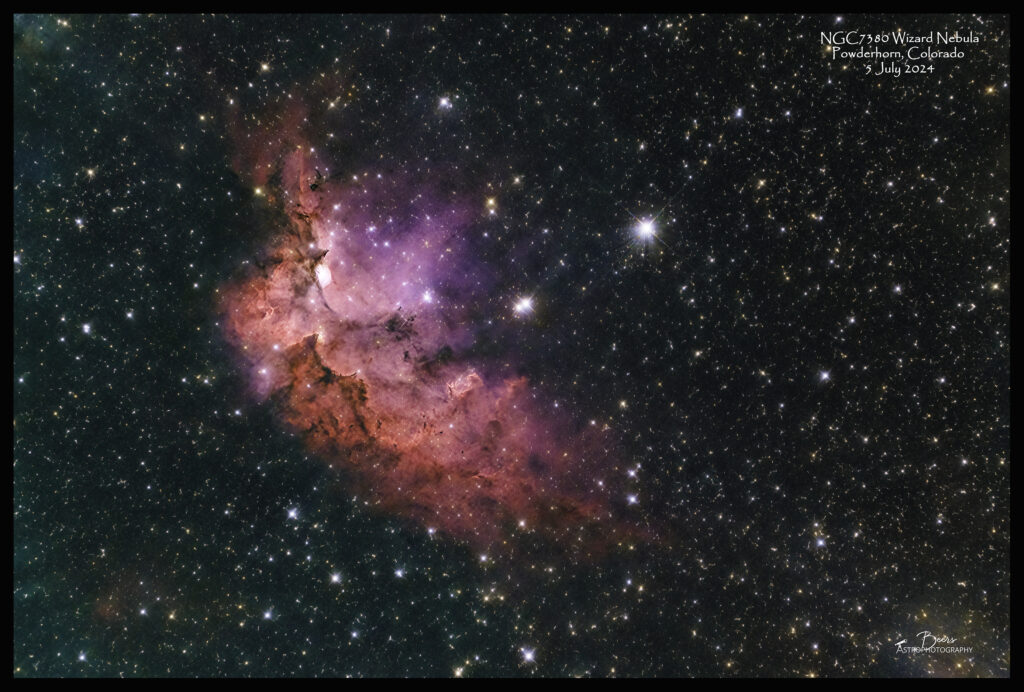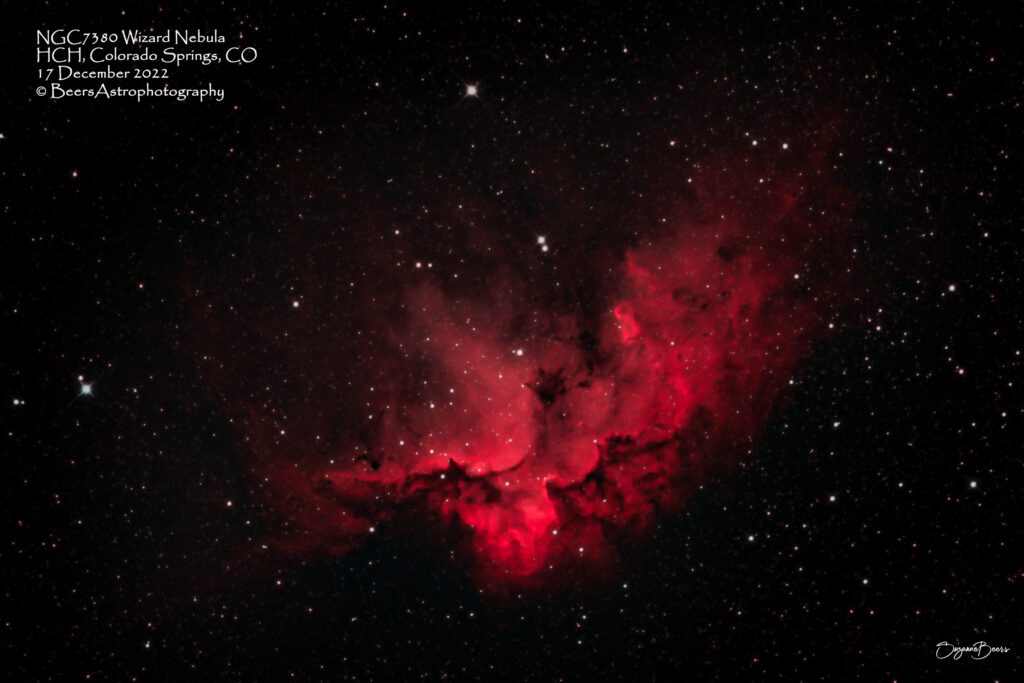
SH2-142/NGC 7380 Wizard Nebula; Captured from Mills Canyon Rim in Kiowa National Grasslands, NM with Big Bertha; 21 September 2025
Target Fun Facts
The Wizard Nebula is often referred to as NGC 7380 but this classification really applies to the young star cluster (3.8 million years old!) associated with this nebulous region. The nebula itself is catalogued in the Sharpless 2 catalogue as Sh2-142. Lying approximately 7,500 light years away in the constellation of Cepheus, the cluster was discovered by Caroline Herschel on 7 August 1787.
There is a magnitude +8.49 eclipsing binary star, HD215835 within the cluster and it is this star along with other members of the cluster that are responsible for the ionization of the surrounding gas cloud that we know as the Wizard Nebula. The nebulosity is punctuated by a series of arcing dust lanes and the radiation and winds from the hot young stars of the cluster cause the nebulosity to glow whilst sculpting the gas and dust into ridges and fronts. The cluster and its associated nebulosity are deep within a huge molecular cloud that is optically invisible, known as NGC 7380E.
{From: https://stargazerslounge.com/topic/325882-the-wizard-nebula-sh2-142/ }
NGC7380 is a young open cluster of stars in the northern circumpolar constellation of Cepheus, discovered by Caroline Herschel in 1787. The surrounding emission nebulosity is known colloquially as the Wizard Nebula, which spans an angle of 25′. German-born astronomer William Herschel included his sister’s discovery in his catalog and labelled it H VIII.77. The nebula is known as S 142 in the 1959 Sharpless catalog (Sh2-142). It is extremely difficult to observe visually, usually requiring very dark skies and an O-III filter. The NGC 7380 complex is located approximately 8.5 kilolight-years from the Sun, in the Perseus Arm of the Milky Way.
The NGC7380 cluster spans ~20 light-years (6 pc) with an elongated shape and an extended tail. Age estimates range from 4 to 11.9 million years. At the center of the cluster lies DH Cephei, a close, double-lined spectroscopic binary system consisting of two massive O-type stars. This pair are the primary ionizing source for the surrounding H II region, and are driving out the surrounding gas and dust while triggering star formation in the neighboring region. Of the variable stars that have been identified in the cluster, 14 have been identified as pre-main sequence stars while 17 are main sequence stars that are primarily B-type variables.
{From: https://en.wikipedia.org/wiki/NGC_7380 }
- Name: The Wizard Nebula (Harry Potter and the Golden Snitch)
- Other Catalog Designations: NGC 7380, SH2-142, LBN511, Cr 452, Ced206
- Subtype: Cluster associated with nebulosity (HII emission nebula)
- Distance from Earth: 5545 light years
- Size: 20 light years
- Apparent Size: 25’ x 20’
- Magnitude: 7.2
- Constellation: Cepheus
{ Information from: Stellarium and https://en.wikipedia.org/wiki/NGC_7380 }
Equipment
Equipment: All equipment controlled by HP Probook running Sequence Generator Pro v4.4.0.1339.
- Imaging (ASI2400-BB-TS-RCFLAT2): ZWO ASI2400MC imaging camera with Teleskop Service Flattener 1.0x for RC Telescopes (TS-RCFLAT2); (Big Bertha) Orion 8″ f/8 Ritchey-Chretien Astrograph Telescope; Teleskop Service (TS) 2.5” Rack and Pinon Focuser M90
- Mount: Rainbow Astro RST-300 (controlled by iHubo ASCOM driver)
- Polar alignment: QHYCCD camera (controlled by Polemaster for polar alignment)
- Autoguiding: Orion 60mm Multi-Use Guide Scope with Orion StarShoot AutoGuider Pro Mono Astrophotography Camera (controlled by PHD2)
- Auto Focuser: ZWO EAF Electronic Automatic Focuser – Standard (New 5V Version) (EAF-5V-STD)
Capture & processing notes
This image was captured with Big Bertha during our September 2025 dark skies trip to Mills Canyon Rim, Kiowa National Grasslands, New Mexico. (See the blog post to read about the Mother Nature-induced debacle that was the camping trip, here I’ll concentrate on the debacle that was the capture and processing!)
I began the night’s imaging with Big Bertha. I hadn’t imaged with Big Bertha since our trip to Comanche National Grasslands in October 2024 – so something is bound to be wrong! To get things (not) started the iHubo ASCOM driver for the RST-300 mount was not connecting through SGPro’s “connect all equipment” command. I rebooted the laptop and recycled power on the mount a couple of times with the same result. I opened Device Manager and verified that the mount was connected through the Com3 port…then went into the iHubo settings to find a blank comm port. I dropped down the iHubo menu – and there it was, waiting to be selected. That did the trick!
Next came the focusing…I slewed to the target area and aborted the focusing routine (which was NOT going to resolve when the telescope is nowhere near in focus). I focused manually while the telescope was pointed in the general direction of the target (first plate solve move), using the auto-focuser’s (EAF) manual option, getting it close to focus, verified the focus on the autoguide camera, then restarted the sequence. The EAF, plate solve, and autoguide calibration went without a hitch…and we were off to the races at 21:07MDT.
BTW…the mosquitos were making this whole experience quite unpleasant by buzzing around my face and ears (and what I came to find out later – biting me through multiple layers of clothing)! I came out at about midnight to do the meridian flip – it all went very smoothly EXCEPT for the mosquitos, who were still out in force, making the entire experience QUITE unpleasant. I decided at that point, even though we had planned to stay for two nights (thus I’d set up both telescopes) I could not deal with another night being a mosquito pin cushion.
So, we came home on Sunday morning versus our planned Monday morning. I’d also decided that since I was planning to take Monday off because we were going to be traveling back – I was still going to take Monday off, to get started on the processing and just have an AP day instead of a work day.
When I started with the processing and produced the v1 NGC 7380 Wizard image, I was disheartened to see a star-traily effect on my reduced star field when I brought the stars and nebulosity back together in the near-final product. I’d seen the same effect with last year’s images from Big Bertha (M20 Trifid Nebula and this image (below) from last year). I began to get an eerie feeling and back-of-the-neck hair-raising concern that something was out of alignment with Big Bertha. (OMG! do I have to learn how to do the collimation process??) I reached out to Nico Carver (…and yes, I have increased my membership level on his Patreon site for the lifeline he’s been), including the v1 image, asking the question if he’d seen anything like this and had ideas on the cause. He responded almost immediately…he’d seen it and it’s an artifact of the way I’m doing my star reduction with Photoshop’s minimize routine. Whew…not great news, but better than having to collimate the telescope.
“My guess from looking at the final image is that it is indeed a processing artifact from how you are doing star reduction in Photoshop. I remember when I used to do star reduction with a minimum filter as you are, getting those kinds of artifacts on a busy star field. These days, about 80% of the time I don’t do any star reduction, but control the visual impact of the star field in the stretch of the stars before recombining them with the starless image. The other 20% of the time when I misjudge the star stretch or just need a little extra reduction, I use Bill Blanshan’s Star Reduction script in PixInsight as it doesn’t leave any artifacts. I know you aren’t using PixInsight yet, but have been considering it.”
— Nico Carver (Nebula Photos) via email, 22Sep2025
I am on the verge of ordering and bracing myself to start my journey up Pixinsight’s steep learning curve (especially in preparation for my new mono camera and filter wheel’s image processing). But, I didn’t want to wait for that, before finishing the processing of this image. So, I spent the next few nights playing around with creating processing versions, combining and masking Arcsinh-stretched non-stretched star fields with the 10% stretch star field (that contained the star diffraction spikes I really like). I had originall posted the result I’d called final is v4 – the Arcsinh30 stretch of the NoStretch star field, using Soft Light blending mode, layered in Photoshop on top of a minimized (4px) version of the 10% star field, masked with a “reveal all” mask to let the star diffraction spikes come through while using the Arcsinh30 (with a 85% brightness enhancement) as the basis of the star field. BUT, then I processed the images from our October 2025 Utah dark skies (and birthday) trip – and tweaked the Bill Blanshan star removal process a bit more…so what is now posted is final v5!
Sequence plan: Gain 158, Offset 30, Temp 0°C; 92x5min. Captured 20Sep2025, 21:07MDT – 21Sep2025, 05:43MDT
Capture Date: 20 September 2025
Shooting location: Mills Canyon Rim, Kiowa National Grasslands, New Mexico
Processing: Captured with SGP, stacked in APP, star removal with Starnet++, processed in LR/PS.
Other images of NGC7380 Wizard Nebula

Capture & processing notes
This image was captured as the second image of the night, on our July 2024 dark skies trip’s second night. During the day, I had attached the ZWO EAF to Big Bertha and set the focuser settings in SGP to the same (changed) settings I had established for the Southern Cross (7 data points, 75 steps). I selected targets for the night: SH2-126 Gecko Nebula for the Southern Cross; M8 Lagoon Nebula and NGC7380 Wizard Nebula for Big Bertha.
During the imaging of M8 Lagoon Nebula, the EAF kept failing so I turned it off and didn’t use it for the rest of the trip – vowing to do some research and practicing when I was not burning precious dark skies times. I had been debating whether I was going to make the switch to NGC7380 spend the entire night imaging M8. The individual subframes of M8 looked great as they were being gathered, so I decided to continue with my plan of changing targets at M8’s meridian flip (~0035) to the Wizard Nebula for the rest of the night.
Sequence plan: Gain: 158, Temp: -0°C, offset=30. 43x5min. Captured 6Jul2024, 0054MDT – 0438MDT. Total exposure time: 3:35hrs (215min, ASI2400-BB)
Capture Date: 5 July 2024
Shooting location: BLM land near Powderhorn, Colorado
Processing: Captured with SGP, stacked in APP, star removal with Starnet++, processed in LR/PS.

Equipment
Polar alignment: QHYCCD camera (controlled by Polemaster)
Imaging stream: Orion 10″ f/8 Ritchey-Chretien Astrograph Telescope; Canon EOS Ra with with Teleskop Service Flattener 1.0x for RC Telescopes (TS-RCFLAT2) and Optilong L-eXtreme light pollution filter
Mount: Sky-Watcher EQ6-R Pro Equatorial Mount (controlled by EQMOD)
Autoguider: Orion 60mm Multi-Use Guide Scope, Orion StarShoot AutoGuider Pro Mono Astrophotography Camera (controlled by PHD2)
All equipment controlled by HP Probook running Sequence Generator Pro v3.2.0.660.
Capture & processing notes
Sequence plan: ISO3200; 70x300sec; captured 17Dec2022 1753MST – 18Dec2022, 0000MST. Total exposure time: 5:50hrs.
Capture: 17 December 2022
Shooting location: Colorado Springs, Colorado
Processing: Stacked in APP, processed in LR/PS.
